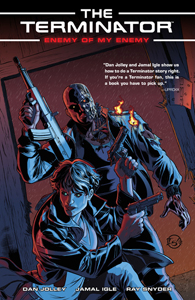The six-issue “Enemy of My Enemy” (2014, Dark Horse Comics) is a throwback to the early days of Dark Horse’s “Terminator” comics. It’s for fans of “The Terminator” as a concept rather than the specific story of Sarah, Kyle and John. But it becomes an increasingly strong character piece from writer Dan Jolley as it goes forward, and by the end, I was ready for more stories about Farrow Greene, a discredited special agent who finds herself joining forces with a T-800.
Focus turns to Farrow
“Enemy of My Enemy” starts off as a corporate espionage story, but by the halfway point, a reader’s need to understand the ins and outs of the espionage gives way to Farrow’s personal journey. Farrow is modeled by artists Jamal Igle (pencils) and Ray Snyder (inks) after “Firefly” actress Gina Torres – as per the suggestion of Jolley (who had dabbled in the Whedonverse with an “Angel” novel and comic story). Her muscles are reminiscent of “T2”-era Sarah, so much so that I thought she was Sarah on one of the early pages.
Jolley and Igle set the action in 1985 via a delicious tip-off on the opening panel that shows “Back to the Future” and other 1985 movies on a marquee. Other period touches such as Farrow’s elaborate cellphone in a suitcase further establish the time.

“Terminator: Enemy of My Enemy” (2014)
Dark Horse, 6 issues
Writer: Dan Jolley
Artists: Jamal Igle, Ray Snyder
The fight scenes between Farrow and the T-800 are fairly kinetic given the limitations of a comic, but it’s the interaction between the two that makes “Enemy” spark. They both want to capture the corporate target, biotechnician Elise Fong (who has developed synthetic skin), and the logic-based T-800 agrees to work with Farrow until that goal is achieved.
Slick blast of action
Jolley nails the brisk and factual speech of the T-800 (model 117, for those keeping a scorecard), and shows off its full complement of skills, from self-repair to voice manipulation. Coolest of all is when the T-800 looks at a mugshot on a computer screen and precisely copies it onto a notepad via pencil in the manner of a dot-matrix printer.
As we see in flashbacks, Farrow has a history of breaking promises, leading to bad outcomes. Her brother was kidnapped when she let him stay out late, and she later botched an undercover job by not trusting her partner. She now goes through life angry and herself and the world, but there’s also a sense that she might change her ways for the better.
In the end, “Enemy” isn’t an essential piece of the lore, but it’s a slick blast of good Terminator action with a strong new lead.
CHARACTERS
Farrow Greene: This disgraced undercover state operative is skilled and strong enough to hold her own against a Terminator.
Dr. Elise Fong: This biotechnician develops synthetic skin, which could be of use in building Terminators. Nonetheless, she’s the target of the T-800.

TERMINATORS
T-800, model 117: It is sent back to 1985 to kill Elise Wong.
Unnamed proto-Terminators: Rothlake (this story’s equivalent of Cyberdyne) develops these robots, which are remote-controlled by a technician in another room. Presumably they were developed via reverse engineering from the Terminator parts left over after the events of “T1.” Why Rothlake gets the parts instead of Cyberdyne is not explained.
CONTINUITY AND CONTRADICTIONS
“Enemy of My Enemy” is set in 1985 after the events of “T1,” breaking into its own timeline with the appearance of the T-800 in Atlanta. The chase then moves to New York City. These are largely untapped locations for a “Terminator” yarn.
In a throwback to Dark Horse’s early “Terminator” yarns, every character in this story is brand-new to the lore. There’s not so much as a mention of the Connors or Kyle, and only the slightest nod to the events of “T1” one year prior.
This Terminator aims to kill Elise Wong, the first developer of synthetic skin. One might think Skynet would want to protect the developer of synthetic skin, not kill her. This oddity goes unexplained. Season 1 of “The Sarah Connor Chronicles” and Dark Horse’s first “Terminator” arc, “Tempest,” are among other stories to explore the creation of artificial tissue.
Rothlake is this story’s equivalent of Cyberdyne. No explanation is given for the change of name.
Rothlake’s development of proto-Terminators in 1985 marks one of the earliest points in time at which the Skynet technology has seen fruition. Rothlake seems to be better at what it does than Cyberdyne is.
TIMELINES AND TIME TRAVEL
This story branches off from the timeline of “T1,” in 1985 in Atlanta, with the emergence of a T-800.

